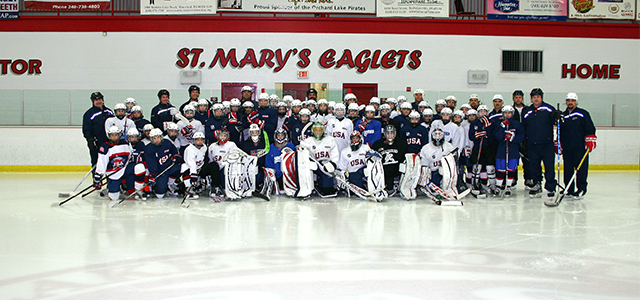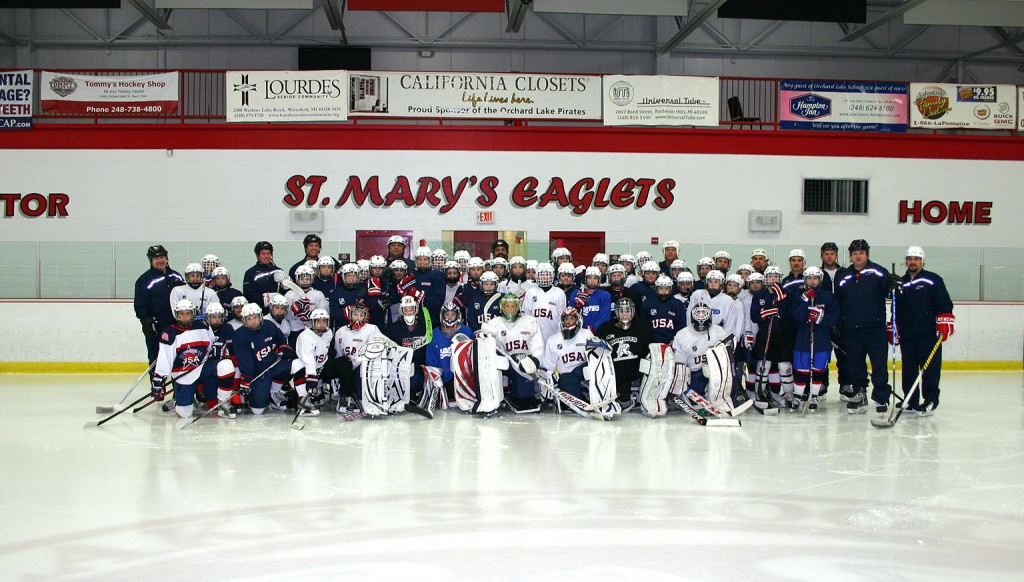Orchard Lake United thriving as USA Hockey model association
After the success of their American Development Model pilot program during the 2011-12 season, the Orchard Lake United hockey association knew they were onto something big.
“That first year we had our two squirt teams and a pee wee team that followed ADM principles and it worked out great,” said Brian Lenaghan, a veteran youth coach and president of Orchard Lake United. “The kids had fun, their skills improved and they wanted to be on the ice. It didn’t take long for us to see that this was the way to train our kids and the way to go forward.”
The pilot program was part of the United’s process of informing parents, players and coaches about the ADM that started in January 2011 with town-hall style meetings and culminated in USA Hockey designating the United as one of the first Model Associations in the country in April 2012.
“At the start we had meetings about every 10 days and invited everyone, not just our association, to come out to learn about the principles of the ADM and what we thought the benefits would be,” said Brian Klanow, the director of St. Mary’s Athletic Complex, the United’s home arena. “Some nights we had 20 people and some nights we had 150.”
The association also invited parents to have their players take part in ADM on-ice sessions that featured small-area games and station-based skill development drills.
“The kids loved it and the parents saw their kids tired, sweaty and having a blast,” said Klanow, also the head coach of the Orchard Lake St. Mary’s high school team. “Looking back on it, that educational component played a big role in helping us create a grass roots ADM transformation.”
Getting it off the ground
Lenaghan and Klanow spent the summer before the 2012-13 season working with Bob Mancini, a United coach and a USA Hockey ADM regional manager, to hammer out the logistics of the Model Association requirements, including adding multiple teams to the association and keeping at least a 3-to-1 practice-to-game ratio – all on the one sheet of ice at their arena.
“We had this great idea, but we were tripling our teams, sharing practice ice and we had 45 hours of ice time a week to do it in,” said Lenaghan, who coaches his son Ryan on the 2001 United White squad. “It was a big undertaking.”
The result was a schedule that put more kids on the ice with an ADM focus on small-area games and skill-based practices.
“And we brought in quality instructors, guys like Lou Melone, to help keep the stations up-tempo and keep the kids going,” said Lenaghan. “That is the art of running the ADM – having two instructors at each station that can push the tempo so the kids work hard, don’t stand around and come off the ice drenched (with sweat).”
Right from the beginning, Mancini was impressed by the dedication of the United’s coaches and how they embraced the ADM principles of age-appropriate skill development.
“It’s very exciting to be a part of this,” said Mancini, who coaches the United’s 2001 Red team that includes his son Victor. “You have to have a strong volunteer group at an association who will put in the time to implement the program.
“But there are so many benefits, not only in individual player development. The coaches are more engaged and understand more about the ADM. And we are spreading the word of the ADM around when we play other teams.”
On-ice success
Last year, Lenaghan’s 2001 United White team made it to the finals of the MAHA state tournament, and this season the association’s 2002 Red team won the LCAHL regular-season title and the District 4 playoff title.
The 2001 United Red team won just five games their first season in 2011-12 and 15 games last year. This season the squad is 35-10-3, was one of three teams to represent Michigan at the prestigious Quebec International Pee Wee Tournament in February and is preparing for the upcoming MAHA state tournament at the Taylor Sportsplex.
“For the most part the nucleus of that team has been together for three years,” said Klanow, whose son Max plays on the squad. “We told our parents three years ago that we were 100% on board with the ADM and the road map hasn’t changed a bit.”
Klanow laments a youth hockey system that places so much importance on wins and losses, to the detriment of developing skating and puck skills.
“The game of hockey is about 10-foot bursts of speed and explosive movements. It’s about giving the puck up and breaking to open ice,” he said. “It’s not about skating end-to-end with the puck because that is not reality. Reality is you need to get from the corner to the front of the net in so many seconds. That is what hockey is. And the ADM teaches reality.”
In addition to increased skill development, the United’s coaches credit the ADM with helping their players learn on-ice awareness and decision making, along with how to use their skills in the context of a real game.
“The process of becoming a good player is a marathon not a sprint,” said Mike Nodler, who joined the 2001 United Red team’s coaching staff this season and whose son Josh plays on the squad. “And you get better at practice. You can’t just turn it on at game time.
“I have been impressed with the intensity of our practices. And when you shrink the ice down the kids get really good at a drill and the skills become second nature when you open it up to the full ice.”
As a benefit of being a Model Association, USA Hockey staff members have made regular visits to the association to talk to the United’s parents and coaches and to help run on-ice sessions.
“The USA Hockey guys have been out at least five times in the last two years,” said Klanow. “They are true hockey people that want nothing more than to help families and players get better. They do a fantastic job. The knowledge that they have and the passion that they show is second to none.”
Lenaghan is proud of the United’s partnership with USA Hockey and that the association continues to help drive the success of the ADM.
“It is only going to get better and grow,” said Lenaghan. “Ten years from now we’ll be able to say we stuck our neck out and that we were pioneers with USA Hockey in promoting the best thing for our kids’ development and the best thing for our country to develop better hockey players.”
This article was originally published on USAHockey.com.


